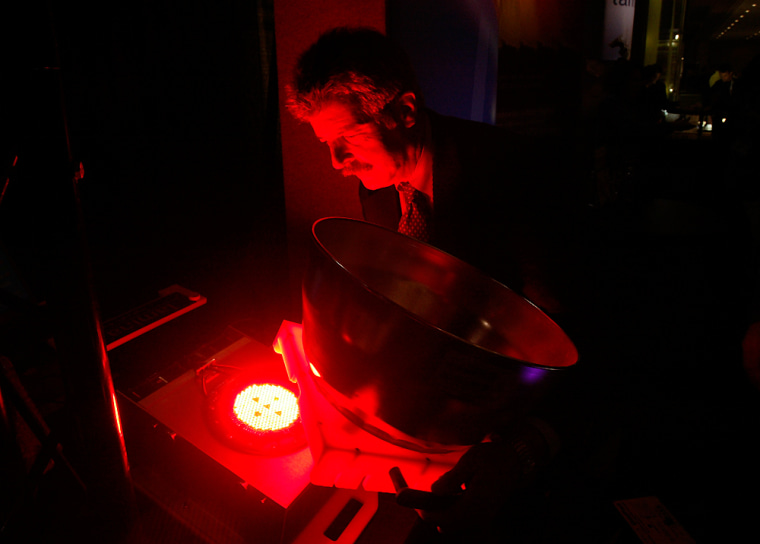If a time traveler from a hundred years ago were to visit a home today, much of the technology would be completely alien. The television, cordless phone and computer would probably leave him flabbergasted.
But on seeing a light bulb, he might say, "Ah! Here's something I recognize. A few of those grace my home, too."
If the visitor comes back in 15 years, the fruit of Thomas Edison's bright idea may be gone. The likely replacement: light-emitting diodes, or LEDs.
LED lamps were unthinkable until the technology cleared a major hurdle just a dozen years ago. Since then, LEDs have evolved quickly and are being adapted for many uses, including pool illumination and reading lights, as evidenced at the Lightfair trade show here this week.
More widespread use could lead to big energy savings and a minor revolution in the way we think about lighting.
LEDs have been around since the 60s, but have mostly been relegated to showing the time in an alarm clock or the battery level of a video camera.
They haven't been used as sources of illumination because they, for a long time, could not produce white light — only red, green and yellow. Nichia Chemical of Japan changed that in 1993 when it started producing blue LEDs, which combined with red and green produce white light, opening up a whole new field for the technology.
And the industry has been quick to exploit it. LEDs are based on semiconductor technology, just like computer processors, and are increasing in brightness, energy efficiency and longevity in a way that's reminiscent of the way each year's new crop of processors is faster and cheaper than last year's.
Earlier this year, researchers at the Lighting Research Center at Rensselaer Polytechnic Institute in Troy, N.Y., said they had boosted the light output per watt of a white LED to almost six times that of an incandescent light bulb, beating even a compact fluorescent bulb in efficiency.
The current generation of mass-produced white LEDs is not as effective. It's about twice as good as a light bulb of the same wattage, but the energy savings aren't enough to overcome the major drawback of being expensive.
"It's hard to convince consumers based on energy savings alone," said Nadarajah Narendran, director of lighting research at Rensselaer. "If you look at compact fluorescent lamps, they're four times as efficient as incandescent lights, and how many homes have those? It's less than 5 percent penetration."
But development is brisk, and the Department of Energy has estimated that LED lighting could cut national energy consumption for lighting by 29 percent by 2025. The total savings on U.S. household electric bills until then would be $125 billion.
LEDs have other advantages that are propelling them into niche uses, despite their upfront cost. Current white LEDs will last up to 50,000 hours, about 50 times as long as a 60-watt bulb. That's almost six years if they're on constantly.
Outdoor uses
That makes them attractive for places where changing bulbs is difficult or expensive — like on the outside of buildings or in swimming pools. Osram Sylvania, the lighting subsidiary of German manufacturer Siemens AG, makes 27-foot long strips of flexible, adhesive tape covered in LEDs for such applications.
Hotels are interested in using LEDs in bedside lamps to save them the trouble of replacing burned-out bulbs, said Jim Anderson of Lamina Ceramics, which showed off a 6-watt array of LEDs that produce light equivalent to a 20-watt halogen bulb.
LEDs are also durable. Being solid-state, they can resist the vibrations in aircraft and cars, according to Narendran, who has worked with Boeing Co. on designs for aircraft cabins.
General Electric Co. and smaller iLight Technologies of Evanston, Ill., make glowing LED signs that look like neon. Neon lighting is a leading cause of fires at restaurants and the signs are vulnerable to vandalism.
By contrast, LED signs made of Plexiglas are tough. At the trade show, iLight exhibited an LED sign that still worked after taking a blast from a shotgun. The limitation: iLight's signs can't be made economically on a one-off basis, as done at small neon-sign shops around the country.
The feature of LEDs likely to propel them into homes is aesthetic, not practical. Arrays that mix red, green and blue LEDs can produce any color of the rainbow. Instead of a dimmer, you might have three sliding knobs that let you mix color.
"On a very hot day you might want blue light to cool it down a bit, or on a winter day you may want to simulate sunlight," said Steve Landau of Lumileds Lighting, an LED-making joint venture of Agilent Technologies Inc. and Philips Lighting.
Qantas Airways Ltd., the Australian airline, recently outfitted its first-class cabin with LED lighting that shines a deep blue when it's time to sleep.
A system like that would be too expensive for most homes, but industry experts believe the price will come down in a few years as the technology develops.
"We are still in a very young research environment," said Norbert Hiller, vice president at Cree Inc. of Durham, N.C., which produces blue and green LEDs. "Our researchers keep surprising us."
